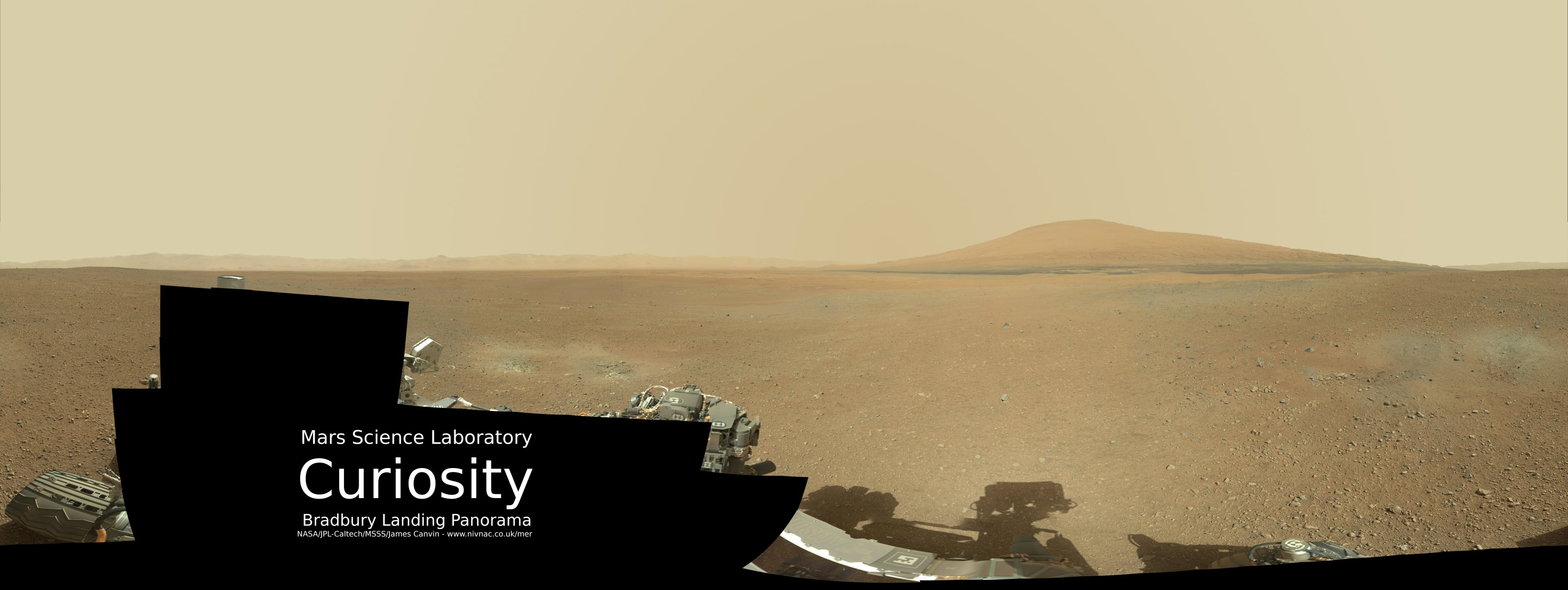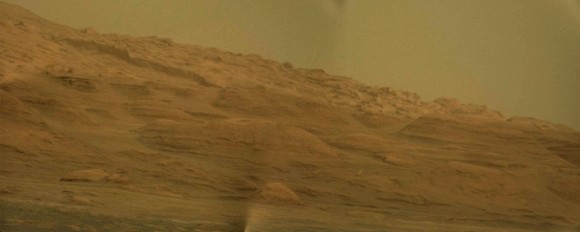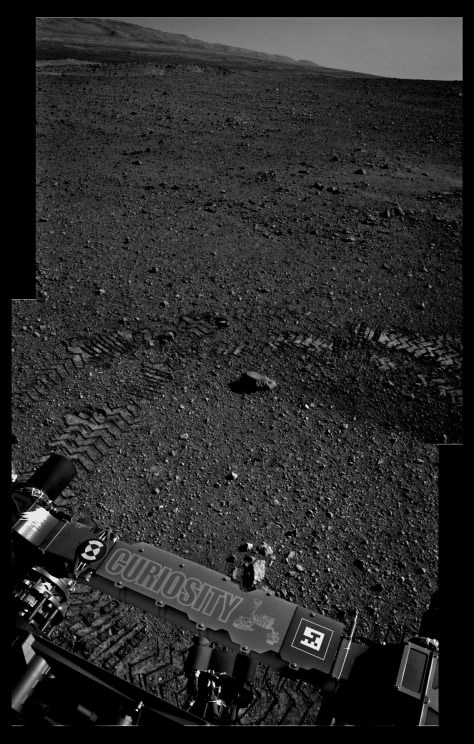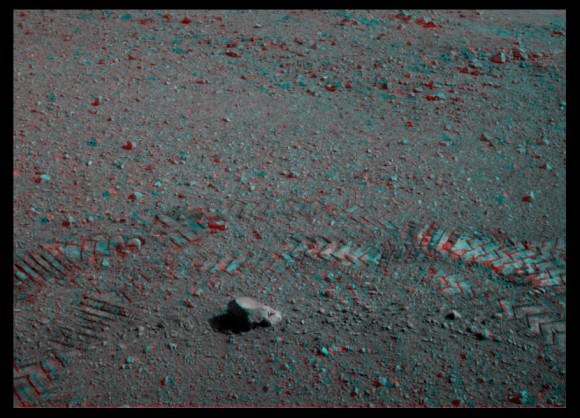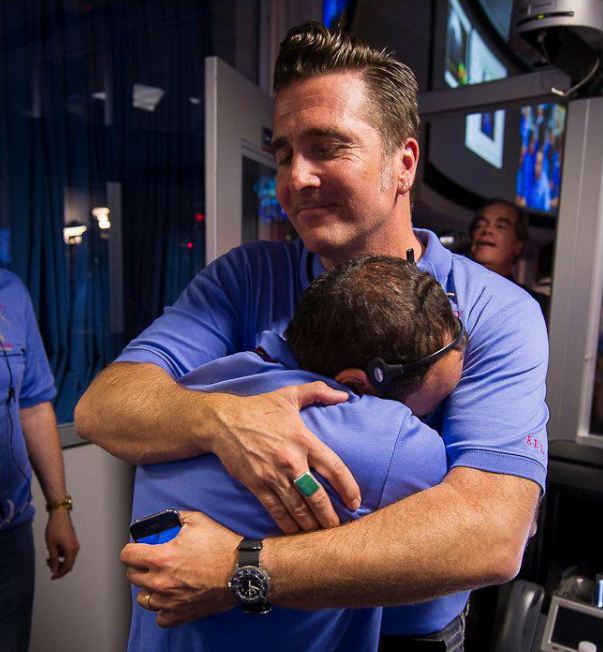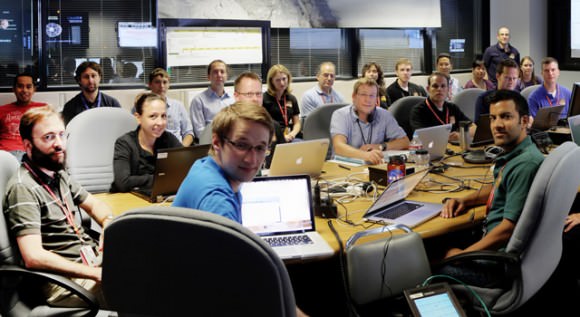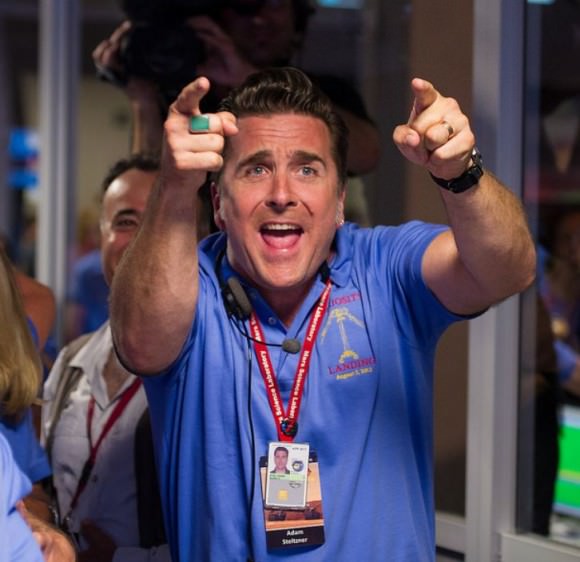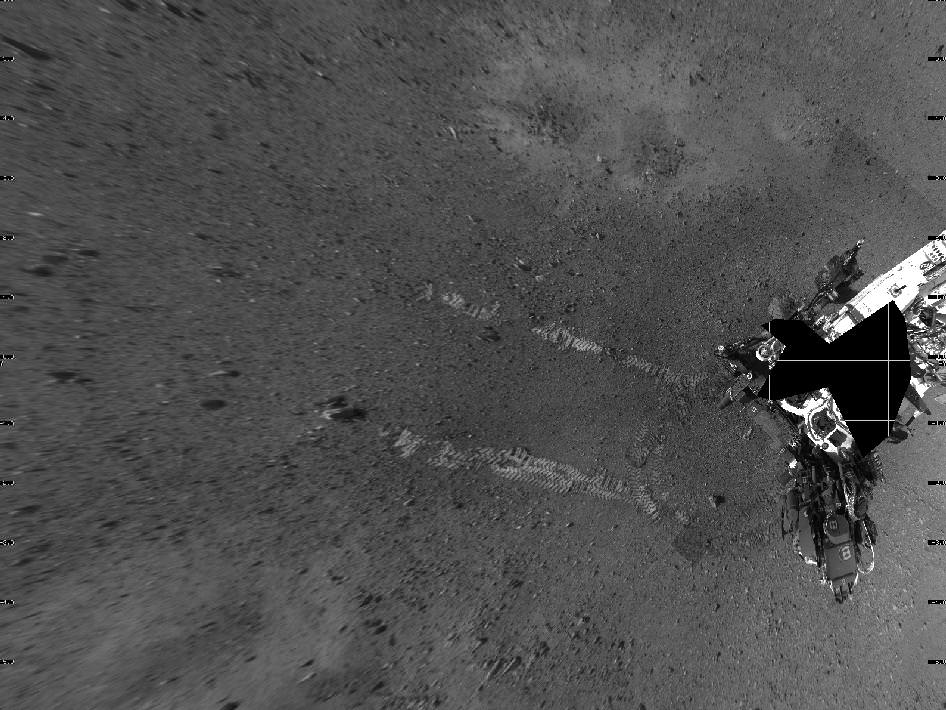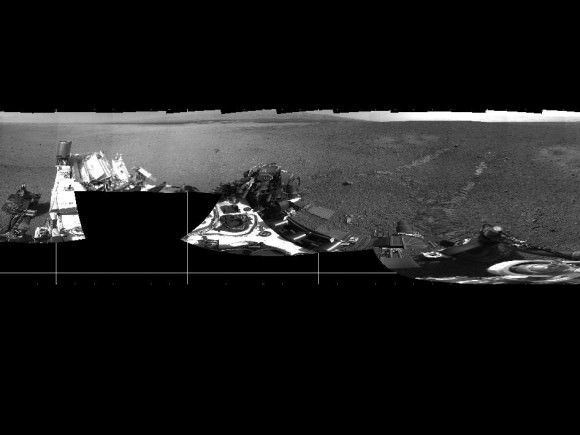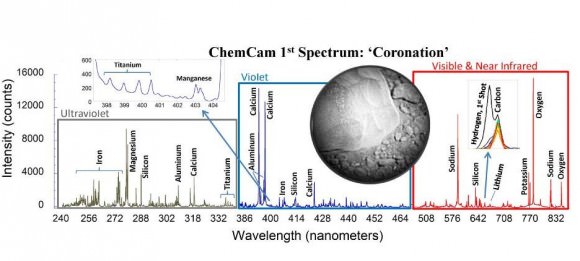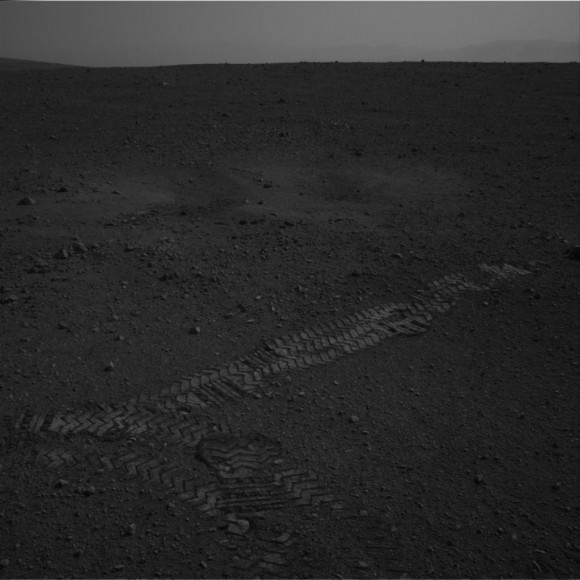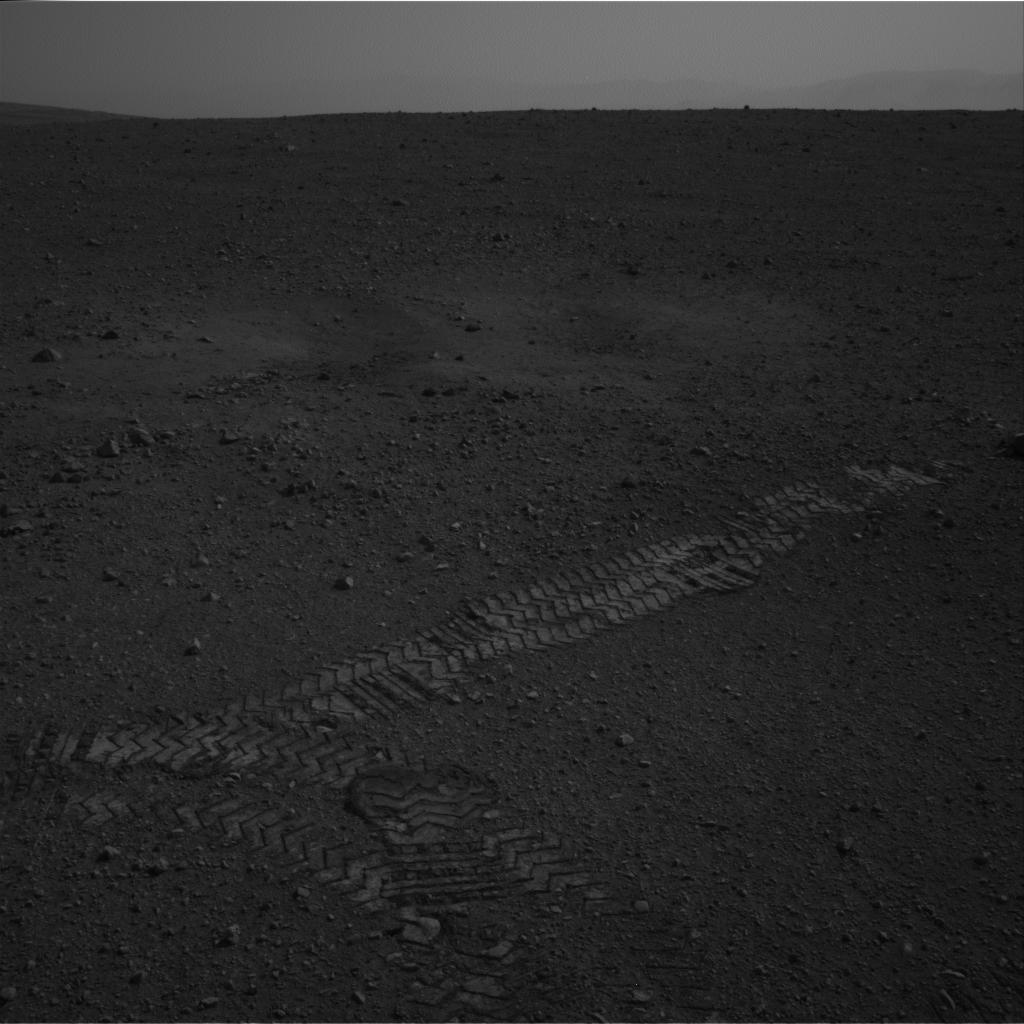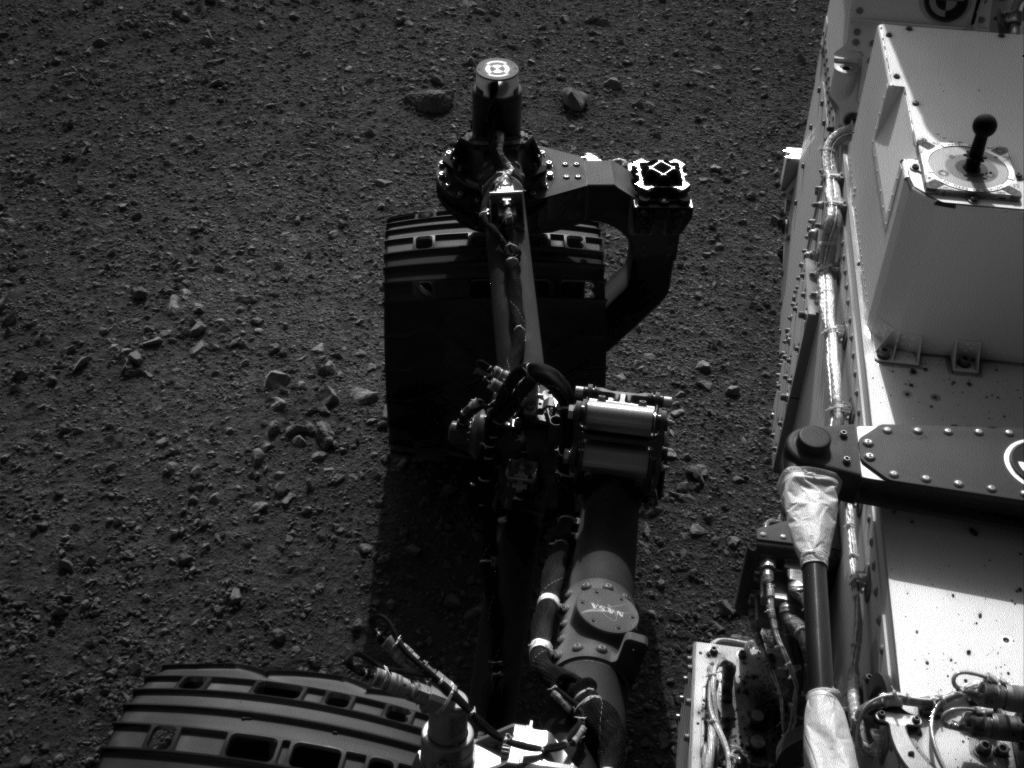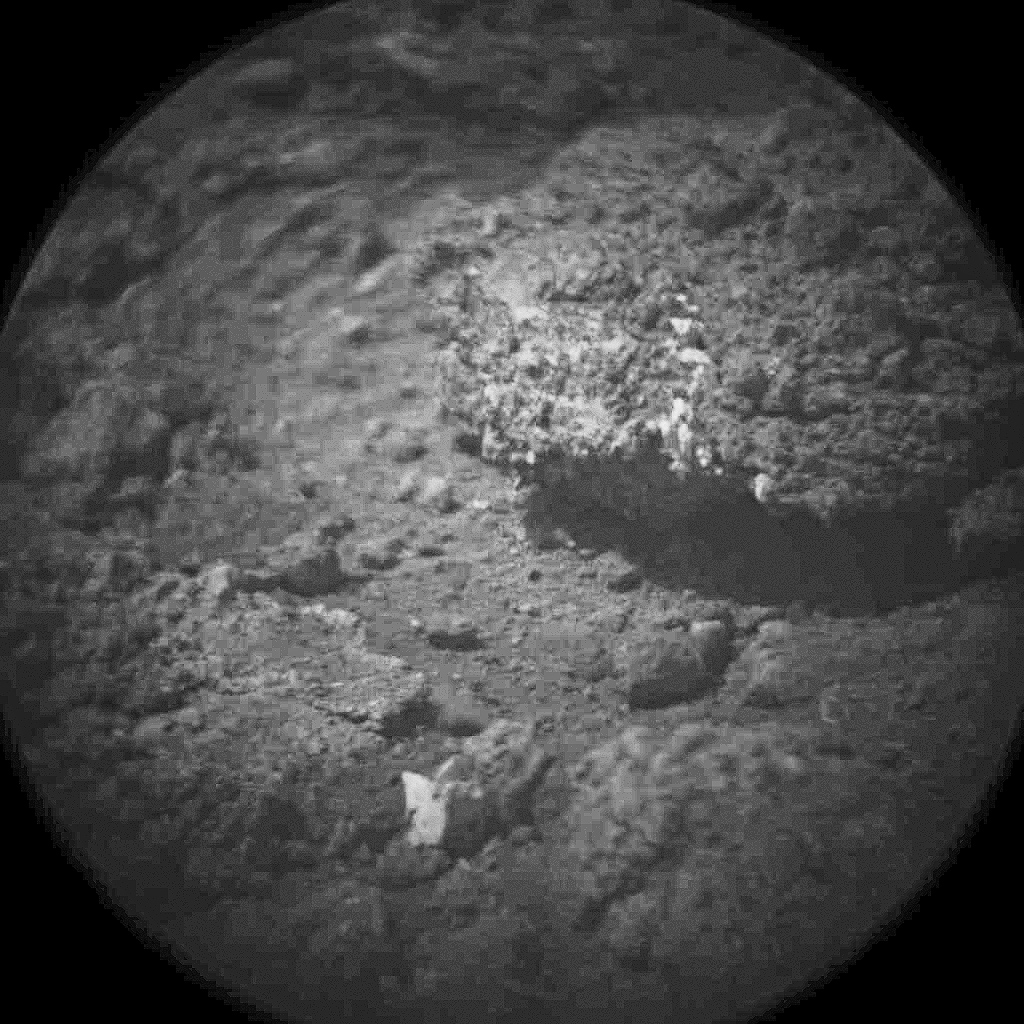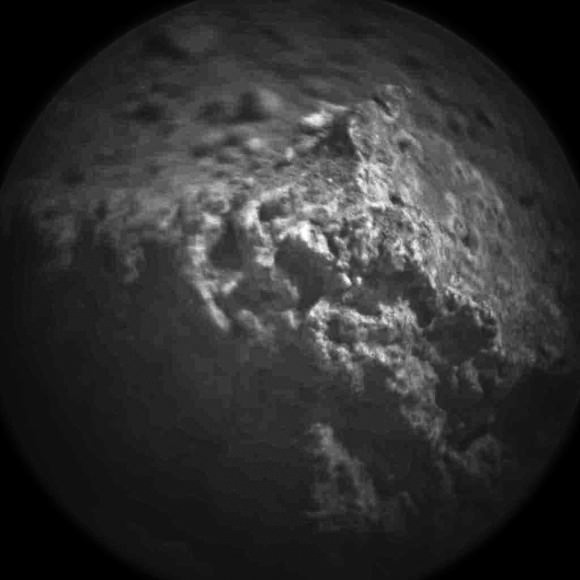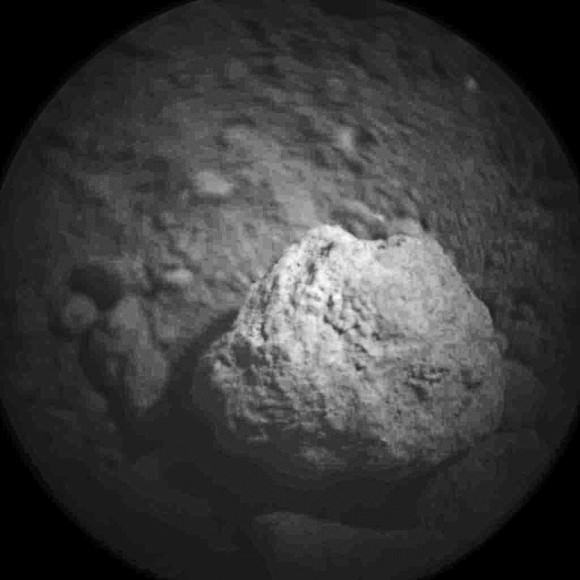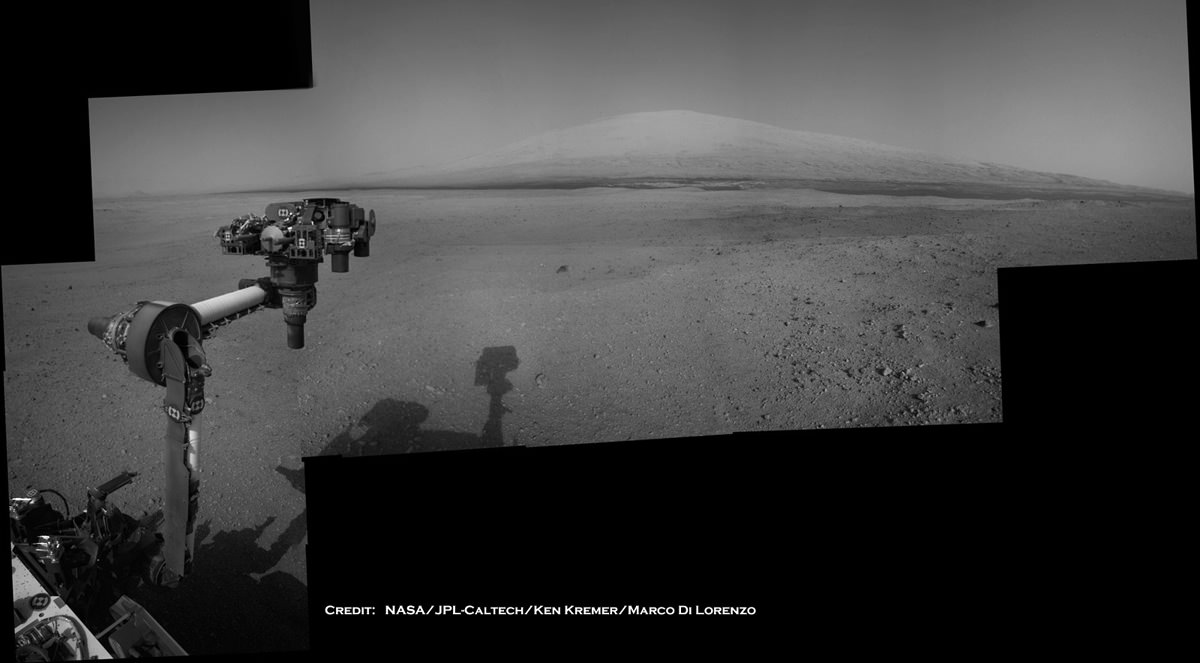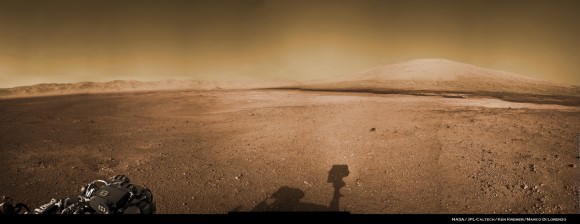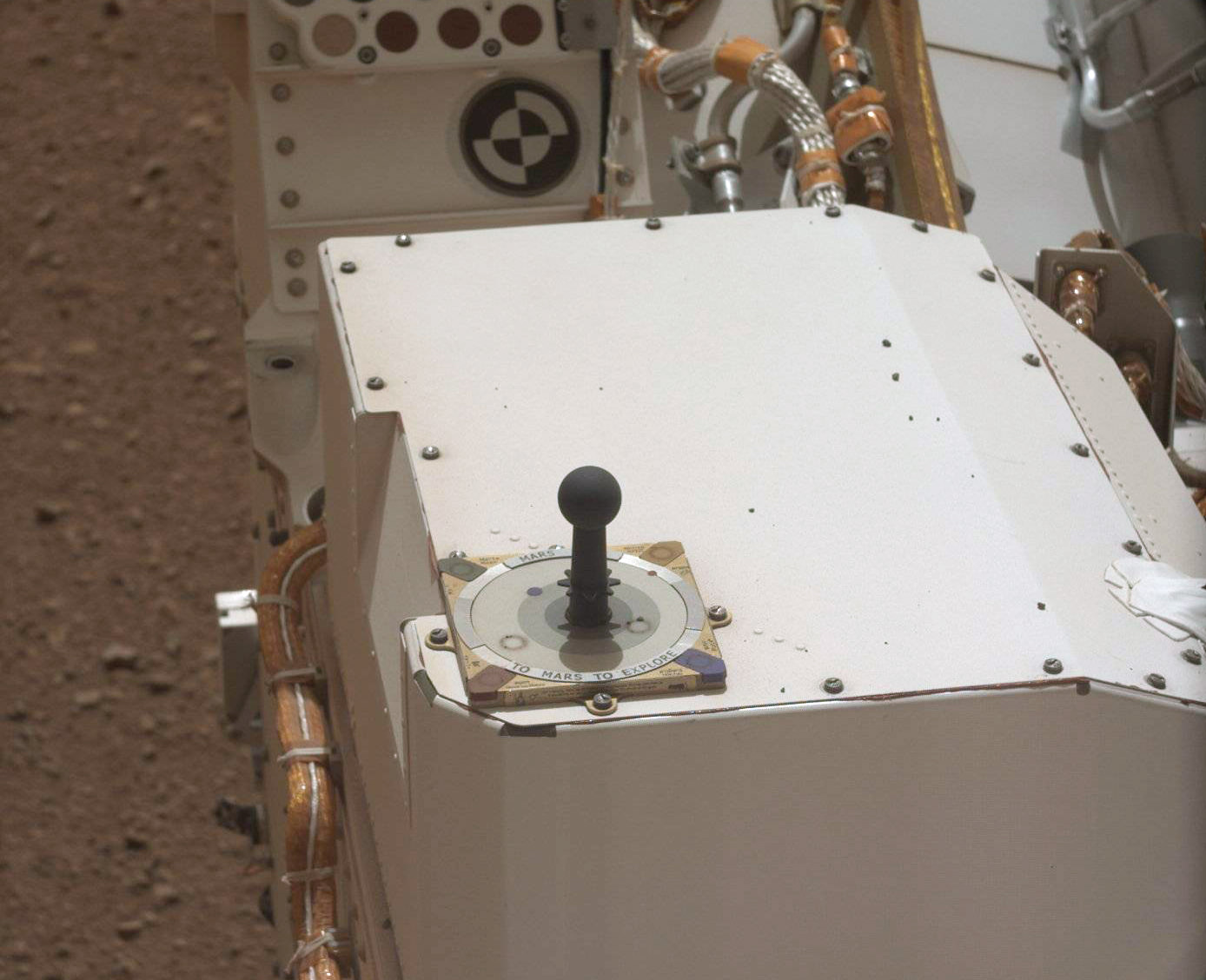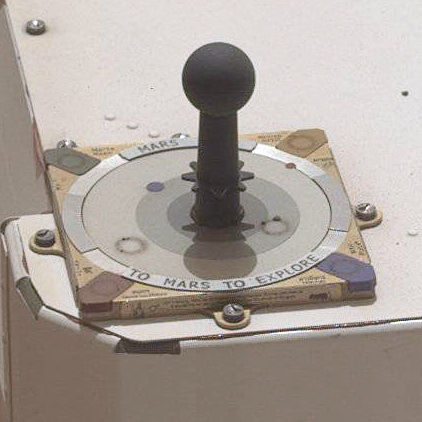This week, Torsten Zorn, MSL Tacticle Downlink Lead, provides an video update on the Curiosity rover’s activities. It’s been a week of firsts — flexing the rover’s robotic arm, zapping with its laser and giving the roving wheels their first workout. The video provides a great look at the rover’s landing site, named for author Ray Bradbury on the day that would have been his 92nd birthday.
Bradbury Landing in Stunning Color and 3-D
Bradbury Landing color panorama. Credit: NASA/JPL-Caltech/Malin Space Science Systems. with image editing by James Canvin.
The image editing wizards at UnmannedSpaceflight are having a field day with all the sensational views being sent back by the Curiosity rover. Above is a beautiful color 360-degree panoramic view edited by James Canvin of the newly named “Bradbury Landing,” Curiosity’s landing place. The view of Aeolis Mons (Mount Sharp) is simply stunning, along with parts of (and shadows of) the rover itself. Click on the image to have access to larger views. James said he added the latest downloads from Curiosity in order to show the top of Aeolis Mons, and extended the sky to make the view complete.
See more views, below:
Aeolis Mons/Mount Sharp. Credit: NASA/JPL-Caltech/image editing by Stuart Atkinson
Here’s a view focusing on just Aeolis Mons by Stuart Atkinson at his wonderful Gale Gazette website, which highlights Curiosity’s latest explorations. He said he “boosted” the colors “just a bit, to bring out some detail.” Click on any of these images to see larger versions from Stu to see more detail — one could spend hours looking at the all the features! And presumably, the MSL science team is doing just that!
And there’s more detail from another image enhanced by Stu, a closeup of one part of the huge mountain in the center of Gale Crater, Curiosity’s ultimate destination for exploration:
The “Promised Land” at the base of Aeolis Mons. Credit: NASA/JPL-Caltech/image editing by Stuart Atkinson
Just look at this intriguing area of mesas and buttes that Curiosity will one day, hopefully be able to explore!
A view of Curiosity and the first tracks left by this rover on Mars. Credit: NASA/JPL-Caltech.
Now it’s time to grab your 3-D glasses to appreciate a the great view from Curiosity!
3-D view of Curiosity’s tracks. NASA/JPL-Caltech/image editing by Stuart Atkinson
3-D view of wheel tracks left by the Curiosity rover on Mars, as captured by the rover’s hazard avoidance cameras. Credit: NASA/JPL-Caltech/Stuart Atkinson
Thanks to Stuart and James and all the UnmannedSpaceflight image editing wizards for providing us all a better appreciation of the location and views from Curiosity’s new science spot. We look forward to more images as they become available! You can see all the raw images straight from Curiosity here.
Behind the Scenes of Curiosity’s Landing Night
Adam Steltzner and another Curiosity team member celebrate the successful landing. Credit: NASA/Bill Ingalls.
I admit, I’ve lost count of how many times I’ve watched the great “trailer” JPL put out showing the events in the mission control room during the Entry, Descent and Landing of the Curiosity rover, which also simultaneously provides animations of what took place on Mars. Watching it usually evokes either 1.) a fist pump, or 2.) choking up.
But if you’ve seen the video, or if you were watching live the night of the landing, just what were all those acronyms and phrases being thrown around and what did they mean? And what was the ever-pacing Adam Steltzner (EDL team leader) hearing in his headphones that made him stop, turn around and point just before spacecraft communicator Allen Chen said, “Touchdown confirmed!” … wherein bedlam ensued?
JPL has put out some info about what all was going on behind the scenes. It turns out the words “UHF Strong,” were highly anticipated by the team, plus there was a bit of acronym trickery employed by the team just so there wasn’t any doubt among them what was going on.
There had been a debate among Curiosity’s ELD team about what their first words to indicate that the rover had reached the surface should be. They knew their microphones would be “hot” and that NASA TV was beaming the landing event out live to everyone watching.*
DC Agle from JPL tells the story:
But they also knew that landing safely on Mars meant more than simply landing on Mars – which any one of the 34 engineers present at JPL’s Building 264 Room 230, also known as the “EDL War Room,” will tell you at great length is not simple at all. Their rocket-propelled backpack and rover-lowering Sky Crane system were getting their first all-up test 154 million miles (248 million kilometers) away from home, and there was still plenty that could go wrong even after the rover was gently placed on the surface… plenty.
What if the descent stage kept descending right on top of the rover? What if the bridles connecting the two did not separate? What if the algorithm used to throttle up the engines for the flyaway maneuver was not accurate?
It was the remaining “what ifs” that made what those first words from Mars confirming the rover was on the surface so important.
“If we said ‘touchdown,’ then people not intimately familiar with EDL might infer that Curiosity was good to go,” said engineer Steve Sell. “But two more major calls had to be made before I could begin to breathe again.”
At 10:31:45 p.m. PDT, Jody Davis saw the event record, or EVR, she was looking for appear on her computer screen in the EDL War Room. She knew that the “Touchdown” EVR would only be beamed down if the rover’s descent stage had throttled down — a result which could only occur if the descent stage had offloaded half its weight. The only way the rover could offload half its weight in an instant is if it were being held up from below.
Davis, a member of the EDL team and an engineer from NASA Langley Research Center in Virginia, gave the much reviewed, pre-scripted call — “Tango Delta nominal.”
Tango and Delta are phonetic identifiers for T and D, which the team used to represent touchdown.
One down, two to go, thought Sell. The next call the EDL team was looking for was “RIMU Stable.”
“RIMU stands for Rover Inertial Measurement Unit,” said Sell. “The RIMU gives us the rover’s orientation as well as any movement it is making. If we landed on a crumbling crater wall or an unstable sand dune, or were being dragged by a still-connected descent stage across the surface, then the RIMU would show that in its data set.”
The War Room’s David Way, an engineer from JPL, was monitoring that unit’s performance. Eight long seconds after Jody’s call, he found the EVR he was looking for.
“RIMU Stable,” said Way.
One more crucial milestone to go.
This image shows Curiosity’s Entry, Descent and Landing (EDL) “war room” and its staff. On the night of Aug. 5, 2012 PDT (early morning Aug. 6 EDT), 34 engineers gathered in this room at NASA’s Jet Propulsion Laboratory, Pasadena, Calif., to support the landing. Image credit: NASA/JPL-Caltech
Not receiving that one final call would be something of a long shot to be sure. After all, the rover was down on the ground, and RIMU indicated it wasn’t moving. Their system had been proven every step of the way so far. But everyone in the EDL War Room got as far as they did not only because they were excellent engineers, but because of their predilection for concocting unappetizing entry, descent and landing scenarios – and then figuring out how to elude them. And one ton of fuel-laden, rocket-firing descent stage climbing straight up, only to fall right back down on their factory-fresh landing site and an otherwise good-to-go, roving Mars laboratory was about as unappetizing a scenario as Sell could imagine.
That final confirmation would not come from Sell’s location. The final confirmation that Curiosity had landed clean would come 200 yards and one building away from the EDL War Room. There, in the Mission Support Area of JPL’s Building 230, Adam Steltzner, the mission’s EDL phase lead, was staring across the room at Brian Schwartz, who was not making eye contact with anyone. Schwartz, the EDL communications engineer, was staring at his screen. His task was not to check for a good-news EVR from the rover. Instead, he was waiting to see if the UHF signal became intermittent, faded away or just cut out altogether – all potential indications that the rover and descent stage had not gone their separate ways.
Eight seconds after the RIMU call – Schwartz looked up.
“UHF strong,” said Schwartz.
With that, Steltzner had all the data he needed. Seated directly in front of the pacing EDL Phase Lead, Allen Chen felt a jab in the shoulder. Chen, the mission’s (capsule communicator), knew it could only mean one thing.
“Touchdown confirmed,” said Chen.
Bedlam and joy.
Mars Science Laboratory (MSL) Entry, Descent and Landing Engineer Adam Steltzner reacts after the Curiosity rover successfully landed on Mars on Sunday, Aug. 5, 2012. Photo Credit: (NASA/Bill Ingalls)
Via Twitter, Steltner told Universe Today that when you see him in the video holding up four fingers, he was actually “counting the seconds waiting for UHF confirmation from Brian Schwartz. I think my fingers were me counting down,” he said.
How did the JPL team know what was happening on Mars? — (there was a 13.8 minute radio delay because of the distance between Earth and Mars).
MSL sent out different tones for each event that happened, and 128 distinct tones indicated when steps in the process were activated; one sound indicated the parachute deployed, while another signaled that the vehicle was in powered flight, and still another that the Sky Crane had been activated. These sounds were a series of basic, special individual radio tones.
They were simple tones, transmitted in X-band, comparable to semaphore codes, rather than full telemetry. The Deep Space Network listened for these direct-to-Earth transmissions. However, Earth went out of view of the spacecraft, “setting” below the Martian horizon, partway through the descent, so the X-band tones were not available for confirming the final steps in descent and landing. By then, the bent-pipe relay of telemetry via the Odyssey spacecraft had begun.
Also listening was the Mars Express spacecraft. It recorded about 20 minutes of the rover’s transmissions and tones. ESA engineers have now put together an audio reproduction, compressing the 20 minutes into about 19 seconds of audio that humans can hear that are a “faithful reproduction of the ‘sound’ of the NASA mission’s arrival at Mars and its seven-minute plunge to the Red Planet’s surface,” the European Space Agency team wrote. You can listen to the audio here.
And if you need to watch the landing trailer one more time, here it is:
*Estimates are that at least 3.2 million people were watching online on JPL’s UStream feed. Universe Today’s Live Hangout on Air Virtual Landing Party had a total of 30,000 viewers, with a peak of 7,000 concurrent viewers. This CNET article says that at the peak, 500,000 people were simultaneously watching the live landing on NASA’s HDTV, JPL, and JPL 2 broadcasts via Ustream. While numbers like this aren’t available for TV, Mashable cites research firm Nielsen’s ratings for the night — CNN had 426,000 viewers, MSNBC had 365,000, and Fox came in the highest with 803,000 — which overall have lower numbers than Ustream.
First Drive for Curiosity Rover an “Historic” Moment
An overhead view of the tracks of Curiosity’s first drive on Mars, taken by the rover’s Mastcam. Credit: NASA/JPL-Caltech
Any rover only gets one ‘first’ drive, and this historic moment has now occurred for the Curiosity Mars rover. “These are historic photos,” said rover driver Matt Heverly, “since there is only one place where your tracks start.”
“It is a really big moment,” said Curiosity Project Manager Pete Theisinger. “We built a rover. Unless the rover roves, we haven’t really accomplished anything.”
This 360-degree panorama shows evidence of a successful first test drive for NASA’s Curiosity rover. On Aug. 22, 2012, the rover made its first move, going forward about 15 feet (4.5 meters), rotating 120 degrees and then reversing about 8 feet (2.5 meters). Curiosity is about 20 feet (6 meters) from its landing site, now named Bradbury Landing. Credit: NASA/JPL-Caltech
And the place where Curiosity departed from now has a new name: Bradbury Landing, named after science fiction writer Ray Bradbury, who would have been 92 today (August 22, 2012).
“This was not a difficult choice for the science team,” said Michael Meyer, program scientist for Curiosity. “Many of us and millions of other readers were inspired in our lives by stories Ray Bradbury wrote to dream of the possibility of life on Mars.”
Curiosity’s first drive was short, but important. “We have a fully functioning mobility system,” Heverly said, adding that the key things about the drive were full revolution of the drivers in forward movement, turning, and back up, plus full revolution of drive actuators, and good data about how the rover perceives its motion. “We’re excited to have this milestone behind us,” he said, “ and it looks like we’re in a great place to do science.”
At a press conference today, Heverly showed an animation (you can see it here) derived from visualization software used for planning the first drive and said the drive took 16 minutes. But only about 4-5 minutes of that was actual driving, as most of the time was spent imaging.
Here’s a video of the team receiving the images:
Heverly said the drive took the rover forward 90 cm, then continued on for a total of 4.5 meters, then at that point took a 120 degree turn around, then backed up 2.5 meters.
The drive occurred at 14:17 UTC (10:17 EDT) today.
The first laser spectrum from the Chemistry and Camera (ChemCam) instrument on NASA’s Curiosity rover. Credit: NASA/JPL-Caltech/LANL/CNES/IRAP
Roger Wiens from the ChemCam team released the first spectrum from “Coronation,” the first rock zapped by Curiosity’s laser and analyzed by the ChemCam instrument. The plot shows emission lines from different elements present in the target, and Wiens said hydrogen showed up initially, but not in later views, meaning that there must have been hydrogen on the surface of the rock.
Weins said they’ve done some more laser shots, and received data from Goldbrun Scour, a place where the skycrane’s thruster dug in and uncovered a small rock outcrop, which appears to be bedrock, since it is layered. But all the rocks so far look to be basalts, which is not surprising, since basalts make up the majority of Mars’ surface.
Curiosity will now be taking what the team called an “intermission” of a few days to a week, where the scientists take a few days to check out the instruments and study the surroundings in more detail before doing any more driving.
“Curiosity is a much more complex vehicle than earlier Mars rovers. The testing and characterization activities during the initial weeks of the mission lay important groundwork for operating our precious national resource with appropriate care,” said Theisinger. “Sixteen days in, we are making excellent progress.”
But Theisinger also cautioned about being too triumphant about what the rover has accomplished in its short time on Mars.
“We are 16 days into a two-year mission.” he said. “We haven’t exercised our sample gathering ability, which is key. As good as it has gone, we’ve only checked off about 2 boxes of the level one requirements – launch on time and land on Mars. But the fact that we haven’t had any early problems is fantastic. But we do need to manage expectations, be prudent and not get ahead of ourselves.”
The next driving destination is an area called Glenelg, approximately 1,300 feet (400 meters) to the east-southeast, where the team can already see three different types of enticing terrain intersecting in one spot.
“When we finally get to Glenelg, we want to study the outcrop there and take a look at the context between the three different terrain types and maybe there is where we would decide to do our first drilling into rock,” said Joy Crisp, the deputy project scientist. “And after Glenelg, we head for Mount Sharp. That will be a much longer drive with probably a few brief stops along the way. That’s going to take several months before we get to that point.”
Tracks on Mars! Image Credit: NASA/JPL-Caltech
Image: Curiosity’s First Wheel Tracks on Mars
The rover (and her driving team) has done it! Curiosity has taken a little jaunt inside Gale Crater and here is an image of the wheel tracks to prove it! This image was taken by the right Navigation Camera on the rover Curiosity on Sol 16 (2012-08-22 15:00:53 UTC).
UPDATE: See our new article from today’s press briefing with more images here.
Image Credit: NASA/JPL-Caltech
Curiosity’s Descent Video in Amazing, Incredible HD Quality
It keeps getting better! This is a full-resolution version of the NASA Curiosity rover descent to Mars, taken by the MARDI descent imager. This video, put together by Daniel Luke Fitch, uses all but a dozen of the full resolution 1600×1200 frames (some haven’t been uploaded from the rover yet). The result is a mind-blowing, HD view of Curiosity’s view as it landed — and it also shows the best views yet of the heat shield impact. Wow!
Watch Curiosity’s First Movements
Click to animate: this gif image shows the movement of the rear right wheel of NASA’s Curiosity as rover drivers turned the wheels in place at the landing site on Mars. Image credit:NASA/JPL-Caltech
She turned her right rear wheel in and turned her right rear wheel out in a sort of Hokey-Pokey-like action in preparation for actually moving inside Gale Crater. Yesterday, the Curiosity rover’s first movements was this “wiggle” of each of the four corner wheels for the first time. Curiosity Mission Manager Michael Watkins said this was a test of the steering actuators on the wheels, and was critical preparation for Curiosity’s first drive on Mars.
Late last night, the rover team sent commands for doing the first drive, and we’ll likely have information on whether that first drive was successful, as JPL has a news conference planned for 17:00 UTC, 1 pm EDT on Wednesday.
Below is a video animation of the rover’s first arm movements, as well:
Other news from the press conference yesterday is that all the instruments are working well on the rover so far, except for one of the instruments on the weather station.
One of the two sets of Rover Environmental Monitoring Station (REMS) wind sensors is not providing data. “One possibility is that pebbles lofted during the landing hit the delicate circuit boards on one of the two REMS booms,” said Curiosity Deputy Project Scientist Ashwin Vasavada of NASA’s Jet Propulsion Laboratory, Pasadena, Calif. “We will have to be more clever about using the remaining wind sensor to get wind speed and direction.”
The rover’s weather station, build by researchers in Spain, checks air temperature, ground temperature, air pressure, wind and other variables every hour at the landing site in Gale Crater. On a typical Martian day, or “sol,” based on measurements so far in the two-week old mission, air temperatures swing from minus 2 to minus 75 Celsius (28 degrees to minus 103 degrees Fahrenheit). Ground temperatures change even more between afternoon and pre-dawn morning, from 3 to minus 91 Celsius (37 degrees to minus 132 degrees Fahrenheit ).
“We will learn about changes from day to day and season to season,” said Javier Gómez-Elvira of the Centro de Astrobiología, Madrid, Spain, principal investigator for REMS.
The team predicts that within a week or so, daily Mars weather reports from Curiosity will become available at this website: http://cab.inta-csic.es/rems/marsweather.html or bit.ly/RzQe6p.
Another instrument provided by Russia is checking for water bound into minerals in the top one meter (three feet) of soil beneath the rover. It employs a technology that is used in oil prospecting on Earth, but had never before been sent to another planet.
“Curiosity has begun shooting neutrons into the ground,” said Igor Mitrofanov of Space Research Institute, Moscow, principal investigator for this instrument, called the Dynamic Albedo of Neutrons, or DAN. “We measure the amount of hydrogen in the soil by observing how the neutrons are scattered, and hydrogen on Mars is an indicator of water.”
The most likely hydrogen to be found in shallow ground of Gale Crater, near the Martian equator, is in hydrated minerals. These are minerals with water molecules, or related ions, bound into the crystalline structure of rocks. They can tenaciously retain water from a wetter past after all free water has gone.
With plans for Curiosity to begin roving, there will soon be new places for all the instruments to measure. The rover team explained the first real drive today will be a very simple execution: forward about 3 meters, then a turn in place of 90 degrees to the right, then a 2-meter drive backwards. Estimates are the rover will end up about 3 meters from its current position and be facing south instead of east.
Emily Lakdawalla has a nice 4-view animation of the rover’s wheel wiggle, showing three wheels and how the shadow of the rover itself moved.
Take a Look Through Curiosity’s ChemCam
This (adjusted) image was taken by ChemCam’s Remote Micro-Imager on Sol 15 (NASA/JPL-Caltech/LANL)
While Curiosity has been getting a good look around its landing spot on Mars, taking in the sights and sending back some impressive views of distant hills and Gale Crater’s enormous central peak, it’s also been peering very closely at some tiny targets just meters away — with its head-mounted, laser-powered and much-touted ChemCam.
The images above and below were acquired by ChemCam’s Remote Micro-Imager on August 21, the 15th “Sol” of the mission. A full-sized image accessed from the public MSL mission site, it’s been brightened quite a bit to show the details of the target rocks.
Mounted to Curiosity’s “head”, just above its Mastcam camera “eyes”, ChemCam combines a powerful laser with a telescope and spectrometer that can analyze the light emitted by zapped materials, thereby determining with unprecedented precision what Mars’ rocks are really made of.
So even though the rover hasn’t actually roved anywhere yet, it’s still performing valuable scientific investigations of Mars — without moving a single wheel. (UPDATE: actually, Curiosity has begun to do some roving — here are some images of its first wheel tracks!)
Read: Curiosity Blasts First Mars Rock with Powerful Laser Zapper
Because ChemCam uses a laser, Curiosity can examine many targets — up to a dozen — within a small time period without having to drive right up to them. Even the dustiest rocks won’t pose a problem for ChemCam – one or two zaps with its laser will be enough to vaporize any loose surface material.
In addition to searching for the building blocks of life hidden inside rocks, ChemCam will also serve a precautionary role for future explorers by helping identify the potential toxicity of Mars’ soil and dust. When astronauts one day land on Mars, they are going to get dusty. It’s important to know if Mars’ dust contains anything dangerous like lead, arsenic (and who knows what else!)
See the latest images from the MSL mission — including more ChemCam pictures — here.
Images: NASA/JPL-Caltech/LANL. Edited by J. Major.
Curiosity Takes Aim at Martian Destination – Mount Sharp
Image Caption: Curiosity Points to Mount Sharp. Curiosity unstowed the robotic arm on Aug. 20 and aimed it directly at her Martian drive destination – Mount Sharp. This mosaic of the robotic arm was assembled from navigation camera images from Sols 2, 12 and 14 and shows 18,000 foot high Mount Sharp in the background and the shadow of the martian robot’s head at center. Curiosity will search for hydrated minerals using the robotic arm and a neutron detector on the body. Image stitching and processing by Ken Kremer and Marco Di Lorenzo. Credit: NASA/JPL-Caltech/Ken Kremer/Marco Di Lorenzo
Curiosity flexed her mighty robotic arm for the first time on Monday (Aug. 20) and aimed the hand-like tool turret squarely at Mount Sharp, her ultimate driving destination.
If you want to see exactly where Curiosity is headed and why she was sent to Gale Crater, just take a look at the new mosaic assembled by Ken Kremer and Marco Di Lorenzo.
Curiosity is pointing with her robotic arm right at Mount Sharp, the huge 18,000 foot tall (5.5 kilometer) mysterious mound that covers the center of the 96 mile (154 km) wide crater. Our mosaic was prominently featured on the front page of NBC News and in a new article by Alan Boyle – here
The layered sediments in Mount Sharp could unveil the geologic history of Mars stretching back billions of years and reveal why the planet transitioned from an ancient, wet period of flowing liquid water on the surface to the dry, desiccated era of today.
As Curiosity unstowed and raised the 7 foot long (2.1 m) arm and reached towards Mount Sharp, the mast mounted navigation cameras on her head snapped a series of black and white images that included the shadow of NASA’s newest Martian robot. The 6 wheeled, car-sized rover made a harrowing pinpoint touchdown barely 2 weeks ago.
The arm is critical to the success of the mission because it will be used to maneuver a sophisticated turret, mounted at the arms terminus and laden with scientific instruments. It weighs a hefty 66 pounds (30 kg) and is about 2 feet in diameter. The turret includes a high resolution focusable color camera, a drill, an X-Ray spectrometer, a scoop and mechanisms for sieving and portioning samples of powdered rock and soil.
“We continue to hit home runs. We unstowed the robotic arm and took a look at the tools on the end of the arm,” said Curiosity Mission Manager Michael Watkins of NASA’s Jet Propulsion Lab (JPL) at a news briefing on Tuesday, Aug. 21. “It’s kind of a Swiss army knife there where we have a lot of instruments. We wanted to make sure all of that was working by doing these first motor checks. All of that went successfully.”
Watkins said the team was thrilled to finally see images of the arm deployed on Mars after seeing thousands of engineering test images.
“We have looked at images thousands of times in our test environment and I always see the walls of the test lab there.Now to see the arm out there deployed with Mars out there in the background is just a great feeling.”
The next step is more tests to confirm the arms utility and movements and calibrate the instruments . “We will fully check out the arm, drill and processing unit,” said Louise Jandura of JPL, sample system chief engineer for Curiosity, at the briefing. “The arm has already performed all these motions on Earth, but in a different gravity condition and that gravity does matter. Our turret at the end of the arm weighs as much as a small child and the differences in gravity change the amount of sag at the end of the arm. We want to be able to fine tune these end-point positions. So it will take some time to put the arm through all its paces.”
What’s more is that Curiosity is wiggling her wheels and is all set to make her first martian test drive on Wednesday.
“Late tonight, we plan to send Curiosity the commands for doing our first drive tomorrow,” said Watkins. “Curiosity will drive about 10 feet, turn right and then back up so her rear wheels will wind up about where her front wheels are now. The cameras will photograph the tracks and evaluate the performance of Curiosity driving ability and the softness of the surface soil.”
The 1 ton mega robot is also equipped with the DAN (Dynamic Albedo of Neutrons) instrument provided by Russia to check for water bound into minerals as hydrates in the top three feet (one meter) of soil beneath the rover.
“Curiosity has begun shooting neutrons into the ground,” said Igor Mitrofanov of Space Research Institute, Moscow, principal investigator for DAN. “We measure the amount of hydrogen in the soil by observing how the neutrons are scattered, and hydrogen on Mars is an indicator of water.”
The mission goal is to ascertain whether the Red Planet was ever capable of supporting microbial life, past or present and to search for the signs of life in the form of organic molecules during the 2 year primary mission phase.
Image Caption: Panoramic Vista of Mount Sharp (at right) and Gale Crater from NASA’s Curiosity rover on Mars. Curiosity will eventually climb 3.4 mile high Mount Sharp in search of hydrated minerals. This colorized panoramic mosaic shows was assembled from new navigation camera (Navcam) images snapped by Curiosity on Sol 2 and Sol 12 and colorized based on Mastcam imagery from Curiosity. Image stitching and processing by Ken Kremer and Marco Di Lorenzo. See black and white version below. Credit: NASA/JPL-Caltech/Ken Kremer/Marco Di Lorenzo Lorenzo – www.kenkremer.com

